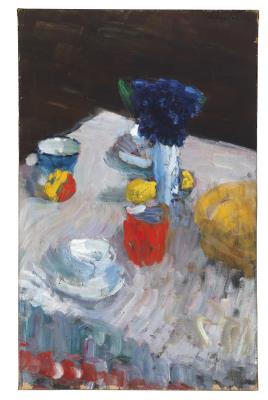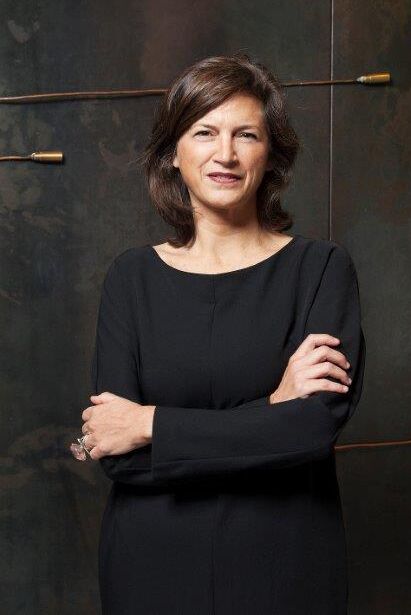Alexej von Jawlensky

(Torschok 1864–1941 Wiesbaden)
Gedeckter Tisch (laid table), around 1904/05, signed A. Jawlensky further signed and inscribed with Stilleben on the stretcher, oil on canvas, 92 x 58 cm, framed
The authenticity of this work has been confirmed by the Alexej von Jawlensky – Archiv.
This work will be included in the forthcoming catalogue raisonné.
Provenance:
Private Collection, Prague / Canada
Private Collection Prague – acquired from the above around 1969
Private Collection, Czechoslovakia then Belgrade
Private Collection, Belgrade – a gift from the above in 1983
Exhibited:
Murnau, 1908/2008 – vor 100 Jahren Kandinsky, Münter, Jawlensky, Werefkin in Murnau, Schloßmuseum Murnau, 11 July – 9 November 2008, exh. cat. page 42, ill. 7 (texts: Bernd Fäthke, Annegret Hoberg, Brigitte Salmen)
Zitat:
“At the time I was painting mostly still-lifes because in them I could more easily find myself. I tried in these still-life paintings to go beyond the material objects and express in colour and form the thing which was vibrating within me, and I achieved some good results.”
Jawlensky, Memories.
Jawlensky began his career by creating mainly still lifes. These, as well as landscapes, were for him subjects that allowed him to approach and, consequently, to better apprehend contemporary art.
In Laid table, painted around 1904/1905, Jawlensky sets a brightly lit table against a dark background. The still life thus proves to be an impressive early work on the threshold of Expressionism.
Perspectively, the viewer's gaze is directed from diagonally above to the table, on which the colors present themselves brightly and colorfully. The objects become almost a secondary matter. The colors dominate.
The brightest color, white, flashes as a pearlescent highlight on the glaze of the cup and mug. In terms of luminosity, white is followed by the yellow of an apple and other, unspecified objects.
Jawlensky places red – one of his favorite colors – in a central position. All other colors and shades - including blue – have the function of emphasizing the three light-strong colors.
The use of light and shadow makes it clear that Jawlensky still used oblique lighting from the upper right to properly stage his still life.
Looking at the chronologically preceding paintings, one can see that Jawlensky's brushwork has become freer – in the sense of more expressive. The formerly calligraphic, actually abstract brushstroke now appears as a motif in combination with progressive stylistic elements of his handwriting, which can be understood as borrowings from Vincent van Gogh and the Neo-Impressionists.
In terms of painting technique – how the colors were applied to the tablecloth with longer brushstrokes and contrasted with faster short staccato strokes at the lower edge of the picture – Jawlensky shows himself to be a confident painter.
Kandinsky, Münter, Jawlensky, Werefkin in Murnau, exh. cat. pp. 42 and 43
Esperta: Mag. Patricia Pálffy
 Mag. Patricia Pálffy
Mag. Patricia Pálffy
+43-1-515 60-386
patricia.palffy@dorotheum.at
23.05.2023 - 18:00
- Prezzo realizzato: **
-
EUR 706.250,-
- Stima:
-
EUR 400.000,- a EUR 600.000,-
Alexej von Jawlensky
(Torschok 1864–1941 Wiesbaden)
Gedeckter Tisch (laid table), around 1904/05, signed A. Jawlensky further signed and inscribed with Stilleben on the stretcher, oil on canvas, 92 x 58 cm, framed
The authenticity of this work has been confirmed by the Alexej von Jawlensky – Archiv.
This work will be included in the forthcoming catalogue raisonné.
Provenance:
Private Collection, Prague / Canada
Private Collection Prague – acquired from the above around 1969
Private Collection, Czechoslovakia then Belgrade
Private Collection, Belgrade – a gift from the above in 1983
Exhibited:
Murnau, 1908/2008 – vor 100 Jahren Kandinsky, Münter, Jawlensky, Werefkin in Murnau, Schloßmuseum Murnau, 11 July – 9 November 2008, exh. cat. page 42, ill. 7 (texts: Bernd Fäthke, Annegret Hoberg, Brigitte Salmen)
Zitat:
“At the time I was painting mostly still-lifes because in them I could more easily find myself. I tried in these still-life paintings to go beyond the material objects and express in colour and form the thing which was vibrating within me, and I achieved some good results.”
Jawlensky, Memories.
Jawlensky began his career by creating mainly still lifes. These, as well as landscapes, were for him subjects that allowed him to approach and, consequently, to better apprehend contemporary art.
In Laid table, painted around 1904/1905, Jawlensky sets a brightly lit table against a dark background. The still life thus proves to be an impressive early work on the threshold of Expressionism.
Perspectively, the viewer's gaze is directed from diagonally above to the table, on which the colors present themselves brightly and colorfully. The objects become almost a secondary matter. The colors dominate.
The brightest color, white, flashes as a pearlescent highlight on the glaze of the cup and mug. In terms of luminosity, white is followed by the yellow of an apple and other, unspecified objects.
Jawlensky places red – one of his favorite colors – in a central position. All other colors and shades - including blue – have the function of emphasizing the three light-strong colors.
The use of light and shadow makes it clear that Jawlensky still used oblique lighting from the upper right to properly stage his still life.
Looking at the chronologically preceding paintings, one can see that Jawlensky's brushwork has become freer – in the sense of more expressive. The formerly calligraphic, actually abstract brushstroke now appears as a motif in combination with progressive stylistic elements of his handwriting, which can be understood as borrowings from Vincent van Gogh and the Neo-Impressionists.
In terms of painting technique – how the colors were applied to the tablecloth with longer brushstrokes and contrasted with faster short staccato strokes at the lower edge of the picture – Jawlensky shows himself to be a confident painter.
Kandinsky, Münter, Jawlensky, Werefkin in Murnau, exh. cat. pp. 42 and 43
Esperta: Mag. Patricia Pálffy
 Mag. Patricia Pálffy
Mag. Patricia Pálffy
+43-1-515 60-386
patricia.palffy@dorotheum.at
|
Hotline dell'acquirente
lun-ven: 10.00 - 17.00
kundendienst@dorotheum.at +43 1 515 60 200 |
| Asta: | Arte moderna |
| Tipo d'asta: | Asta in sala con Live Bidding |
| Data: | 23.05.2023 - 18:00 |
| Luogo dell'asta: | Wien | Palais Dorotheum |
| Esposizione: | 13.05. - 23.05.2023 |
** Prezzo d’acquisto comprensivo dei diritti d’asta acquirente e IVA(Paese di consegna Austria)
Non è più possibile effettuare un ordine di acquisto su Internet. L'asta è in preparazione o è già stata eseguita.
